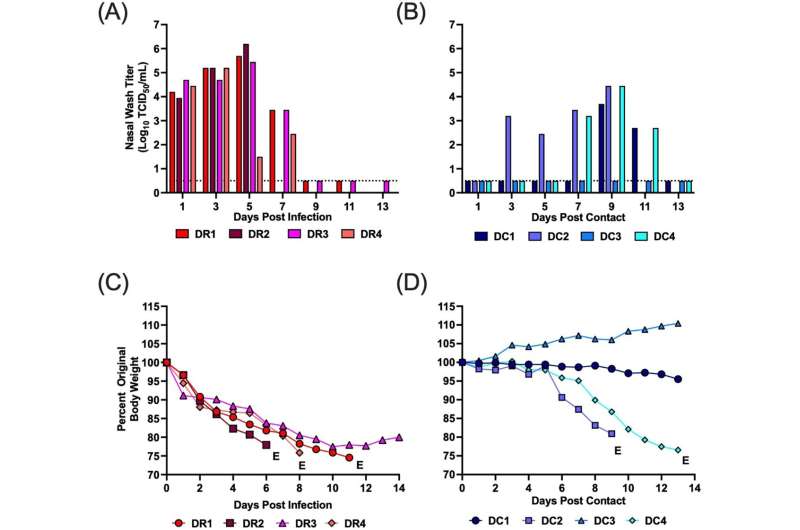This article has been reviewed according to Science X's editorial process and policies. Editors have highlighted the following attributes while ensuring the content's credibility:
fact-checked
peer-reviewed publication
trusted source
proofread
Study finds H5N1 virus from 2022 mink outbreak capable of inefficient airborne transmission

Highly pathogenic H5N1 avian influenza was detected in dairy cattle for the first time in the United States in March 2024, with nine states reporting outbreaks by May. While the method of transmission among cattle is currently unknown, new research published in Nature Communications demonstrates that a related strain of H5N1, subtype clade 2.3.4.4b, which caused an outbreak in farmed mink in 2022, has transmitted through the air to a limited number of ferrets.
This is the first time that a member of the group of H5N1 clade 2.3.4.4b viruses has been shown to exhibit this ability. According to the Penn State researchers who led the study, the findings suggest these viruses are evolving to infect mammals and with potentially increased risk to humans.
"While there is no evidence that the strain of H5N1 that is presently affecting dairy cattle is capable of airborne transmission, our study suggests that another member of this family of viruses has evolved some degree of airborne transmissibility," said Troy Sutton, associate professor of veterinary and biomedical sciences, Penn State, and corresponding author on the paper. "This finding underscores the importance of continued surveillance to monitor the evolution of these viruses and their spillover into other mammals, including humans."
According to the researchers, assessing a virus's potential for airborne transmission in mammals could inform the understanding of its potential risk to humans. Since virus samples could not be readily obtained after the outbreak in mink had been controlled, the team reconstructed the virus using publicly available genetic sequences.
Next, the researchers evaluated the ability of the virus to transmit in ferrets, which have respiratory tracts that are more similar to humans in their susceptibility to viral infection and transmission than other model organisms, such as mice. The team measured both direct transmission of the virus (by placing infected ferrets in cages with uninfected ferrets) and indirect airborne transmission (by placing infected and uninfected ferrets in cages that enabled shared airspace but prevented physical contact). To assess disease severity, the team examined the ferrets' weight loss and signs of clinical illness.
The researchers found that the virus transmitted by direct contact to 75% of exposed ferrets and by respiratory droplets to 37.5% of exposed ferrets after about nine days of exposure. The team also found that the virus had a low infectious dose, meaning that even small amounts of virus caused an infection.
Sutton noted that the mink strain of the virus contained a mutation, called PB2 T271A. To test the influence of this mutation on viral transmission and disease severity, the team engineered the virus without the mutation and found that mortality and airborne transmission in the ferrets infected with this version of the virus was reduced.
"These findings suggest that the PB2 T271A mutation is enhancing viral replication of the virus, contributing to both virulence and transmission in ferrets," Sutton said. "Understanding the role that this mutation plays means we can monitor for it or for similar mutations to arise in the currently circulating strains of H5N1."
Sutton added that the ferrets that the team used in its studies had no pre-existing immunity to influenza, whereas the majority of humans have been exposed to H1N1 and H3N2 seasonal influenza viruses.
"This exposure would likely offer some degree of cross-protection against H5N1 if humans are exposed to another H5N1 variant," he said.
Furthermore, he said that the transmission rate the team observed in the mink virus is lower than is typical for pandemic influenza viruses.
"Pandemic influenza viruses typically transmit via the airborne route to 75% to 100% of contacts within three to five days, whereas the mink virus we studied transmitted to fewer than 40% of contacts after nine days," Sutton said.
"The transmission observed in our studies is indicative of increased pandemic potential relative to previously characterized strains of H5N1; however, the mink virus does not exhibit the same attributes as pandemic strains. The H5N1 strain affecting cattle also has not caused severe disease in cattle or humans, but the longer the virus circulates, and the more exposure humans have to it, the greater the chances that it will evolve to infect humans."
This research was conducted in Penn State's Eva J. Pell Advanced Biological Laboratory, a high-containment biosafety level 3 enhanced laboratory that is regularly inspected by the Centers for Disease Control and Prevention and the United States Department of Agriculture.
Other Penn State authors of the paper include Katherine Restori, assistant research professor in veterinary and biomedical sciences, as well as Kayla Septer, Cassandra Field and Devanshi Patel, all graduate students in veterinary and biomedical sciences. David VanInsberghe, postdoctoral fellow; Vedhika Raghunathan, graduate student; and Anice Lowen, professor of microbiology and immunology, all at Emory University, also are authors of the paper.
More information: Katherine H. Restori et al, Risk assessment of a highly pathogenic H5N1 influenza virus from mink, Nature Communications (2024). DOI: 10.1038/s41467-024-48475-y



















